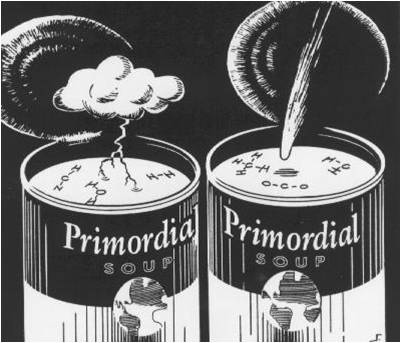 Overview:
Overview:
V. Origin of Life Hypotheses
 Overview:
Overview:
As curious scientists, we are always interested in beginnings - what causes this or that. Events that occur repeatedly are obviously easier to study through science than events that occur once. In fact, for events that occur once, all we can really do in science is establish correlation - we can't replicate the event, so we can't test it directly. But, we can ask post-dictive hypotheses and make other tests of important explanatory elements. For instance, general relativity and the big bang theory predicted more than just "the expansion of the universe". It predicts the existence of black holes and the behavior of atoms and heavenly bodies under new situations. These have been tested and verified, so we have confidence in the explanatory power of general relativity, in general (ha-ha). This gives us greater confidence in it's explanatory relevance to the universe, as well, even though we can't "create another universe" and test it completely. The origin of life, like the origin of the universe, is such a question. As far as we know, life originated once - on a rocky planet orbiting a sun in a distant arm of a spiral galaxy.
Before we get started presenting idaes about how this process may have occurred, it is important to distinguish "origin of life" hypotheses from "evolution". These are two very different issues with different degrees of empirical support. Evolution is "a change in the genetic structure of a population". Evolution explains the way life changes through time, and the creation of new species as a result of divergence from existing species. AS SUCH, evolution assumes the existence of life. Evolutionary theory, explicitly, is independent of hypotheses regarding how life began. However, evolution does suggest that life is related by common ancestry to some initally successful type of life. Again, however, how those initial life forms arose is a different question. It is analogous to the Copernican Theory of a sun-centered universe. That theory describes how the planets move, but makes no claim to explain how the planets formed. Nonetheless, long before anyone had a good idea about how the solar system formed, the Copernican Theory was accepted as a useful explanation of the movement of the planets. Likewise, evolution describes how life changes over time, and is not really dependent on an particular explanation of how life first arose. And, like the Copernican Theory, Evolutionary Theory has been accepted as a useful description of how life changes through time without yet knowing how life first arose. Critics of evolution often confuse these points, suggesting that evolution is suspect because we do not know how the first life arose. Hopefully, after the last couple weeks, you can see the difference between "evolutionary theory" and "origin of life hypotheses".
The origin of life presents some very interesting (if not novel) problems. For example, even the simplest living cells are very very complex, and are composed of interdependent subsystems. It is difficult to postulate how this complex system could have arisen by stepwise, evolutionary processes from non-living systems. Indeed, having just learned about protein synthesis, one of the more interesting problems may occur to you: if DNA codes for proteins, but protein enzymes are needed to replicate and transcribe DNA, how could one come before the other? It would seem that both proteins and DNA would have to evolve at the same time for the system to work. You would be correct to conclude that this would be highly unlikely. However, our inability to see an answer does not mean that an answer does not exist. Indeed, hard-working scientists have actually figured out a very reasonable hypothesis for how our current genetic system could have evolved - and we will see that hypothesis in this lecture. For a very detailed, recently updated summary of the work on origin of life chemistry, see: Moritz 2010.
A. The Early Earth
1. Formation of the Earth
In order to form hypotheses about how life could originate, we need to gain some appreciation for what the early earth environment would have been like. This is essential, because environmental conditions will determine what types of chemicals may have been available and what type of chemical reactions may have been able to take place. Since the early earth environment was probably a function of how the planet formed, we will take one more step back to address that question: how did the earth form?
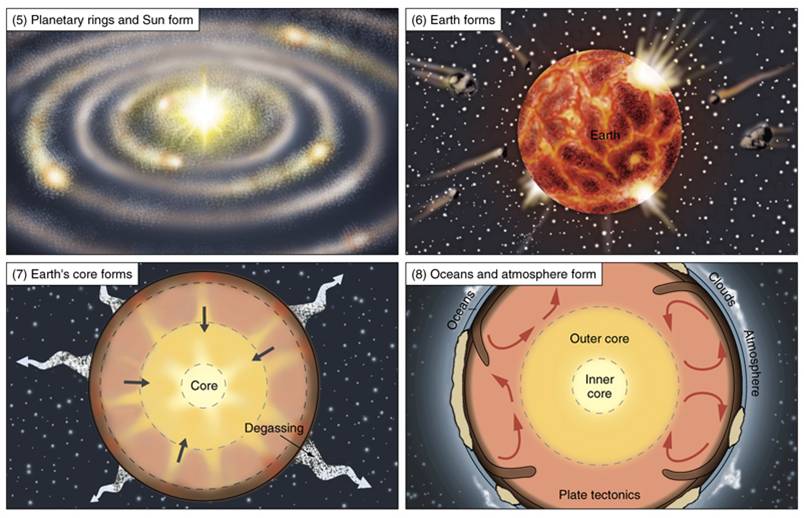 The
standard working model (theory) of earth formation goes like this. Our solar
system probably formed as a gas nebula began to condense and spin, perhaps because
the explosion of a nearby supernova caused the gas cloud to collapse on itself. As
this gas cloud collapsed and began to rotate, the center continued to collapse,
form a strong gravitational field, heat up, and ultimately radiate light and
energy (sun). Under this gravitational field, the rest of the spinning gas cloud
flattened into a protoplanetary disk. The debris orbiting the sun at the same
distances collided and formed larger bodies called 'planetissimals', which continued
to collide and accrete. As these objects became larger, their masses and gravitational
fields increased and they swept more material up as they orbited the sun - eventually
resulting in a few large bodies at different distances (planets). Temperatures
were too hot near the sun for volatile molecules (like water) to condense, so
only matter with higher melting points - like metals, condensed to form the
inner, rocky planets. Volatile molecules could condense farther from the sun,
creating the huge gas giants of the outer solar system. The gravitational fields
of Jupiter and Saturn were so large that they disturbed the formation of any
large bodies nearby - so the planetissimals in the asteroid belt between Mars
and Jupiter failed to form planets or were ripped apart by gravitational forces
of Saturn and Jupiter.
The
standard working model (theory) of earth formation goes like this. Our solar
system probably formed as a gas nebula began to condense and spin, perhaps because
the explosion of a nearby supernova caused the gas cloud to collapse on itself. As
this gas cloud collapsed and began to rotate, the center continued to collapse,
form a strong gravitational field, heat up, and ultimately radiate light and
energy (sun). Under this gravitational field, the rest of the spinning gas cloud
flattened into a protoplanetary disk. The debris orbiting the sun at the same
distances collided and formed larger bodies called 'planetissimals', which continued
to collide and accrete. As these objects became larger, their masses and gravitational
fields increased and they swept more material up as they orbited the sun - eventually
resulting in a few large bodies at different distances (planets). Temperatures
were too hot near the sun for volatile molecules (like water) to condense, so
only matter with higher melting points - like metals, condensed to form the
inner, rocky planets. Volatile molecules could condense farther from the sun,
creating the huge gas giants of the outer solar system. The gravitational fields
of Jupiter and Saturn were so large that they disturbed the formation of any
large bodies nearby - so the planetissimals in the asteroid belt between Mars
and Jupiter failed to form planets or were ripped apart by gravitational forces
of Saturn and Jupiter.
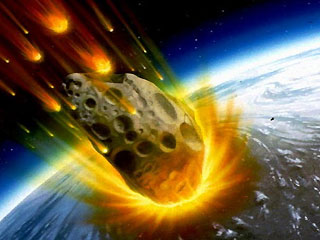 The
gravitational effects of the large planets on the asteroid belt would also have
disturbed asteroid from their orbits, causing them to crash with one another
and sending them ricocheting in towards the inner planets (and the other way,
out of the solar system). This meteor bombardment would have brought water (condensed
on these distant meteorites) to Earth. However, this constant bombardment also
may have incinerated any early life. Interestingly, the earliest fossils date
to 3.4 billion years ago (by), about the time that the period of heavy bombardment
stopped. The oldest minerals on Earth, and the oldest rocks from the moon and
meteorites, are 4.4-4.5 by; giving a reliable age to the final accretionary
period and the formation of the planets.
The
gravitational effects of the large planets on the asteroid belt would also have
disturbed asteroid from their orbits, causing them to crash with one another
and sending them ricocheting in towards the inner planets (and the other way,
out of the solar system). This meteor bombardment would have brought water (condensed
on these distant meteorites) to Earth. However, this constant bombardment also
may have incinerated any early life. Interestingly, the earliest fossils date
to 3.4 billion years ago (by), about the time that the period of heavy bombardment
stopped. The oldest minerals on Earth, and the oldest rocks from the moon and
meteorites, are 4.4-4.5 by; giving a reliable age to the final accretionary
period and the formation of the planets.
The Earth's own gravitational field pulled the heavy elements (nickel iron) towards the core. As they moved, frictional heat was produced that warmed and vaporized lighter material in the Earth's crust, which moved towards the surface and was released during periods of intense volcanic activity. This"degassing" (release of lighter elements) formed the atmosphere, and created a density gradient from the dense core to the lighter silicates in the Earth's crust, to the lightest, gaseous molecules in the atmosphere. The moon is too small to have a heat-generating core, so it has no history of vulcanism - its "craters"are all impact craters. Mars had volcanoes...in fact, the largest known volcano in the solar system is on Mars. However, because it is smaller, it is no longer tectonically active.
2. The Early Atmosphere:
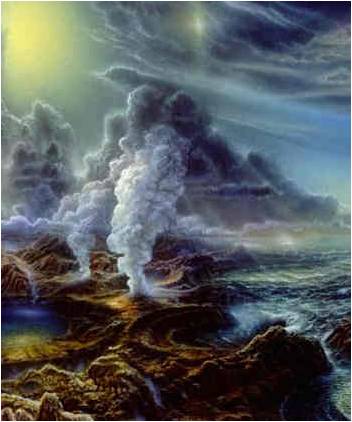 Any
free hydrogen or helium gas would have been too light to have been held by the
Earth's gravitational field at the time, and was lost to space. The gases released
by volcanoes would have been held as the first permanent atmosphere. Because
the process of vulcanization and the burning of rock is thought to be the same
today as it was throughout Earth history, we can determine the composition of
volcanic gases today and have a pretty good idea of the composition of the early
atmosphere. These volcanic gases are carbon dioxide (CO2), and water
vapor (H2O), Hydrogen gas (H2), Nitrogen gas (N2),
Hydrogen sulphide (H2S), and trace amounts of methane (CH4)
ammonia (NH3), and HCl.
By about 4.4 by, geologists surmise that the earth may have cooled to the point
that water vapor would condense; raining down to fill the ocean basins. However,
through the period of heavy bombardment by meteorites, it is likely that much
of Earth's surface waters were repeatedly vaporized by the energy of these impacts.
After the period of bombardment, the ocean basins filled for good. Liquid water
has had a profound effect on the chemistry of our planet. For example, many
of the volatiles released by volcanoes went into solution easily - such as CO2,
HCl, and SO2. But N2 is not soluble so it remained behind
and dominates our atmosphere (~78%). The sulphuric, nitric, and carbonic acids
that precipitate with the condensing water dissolve rock, washing the dissolved
salts to the ocean where their concentration accumulates.
Any
free hydrogen or helium gas would have been too light to have been held by the
Earth's gravitational field at the time, and was lost to space. The gases released
by volcanoes would have been held as the first permanent atmosphere. Because
the process of vulcanization and the burning of rock is thought to be the same
today as it was throughout Earth history, we can determine the composition of
volcanic gases today and have a pretty good idea of the composition of the early
atmosphere. These volcanic gases are carbon dioxide (CO2), and water
vapor (H2O), Hydrogen gas (H2), Nitrogen gas (N2),
Hydrogen sulphide (H2S), and trace amounts of methane (CH4)
ammonia (NH3), and HCl.
By about 4.4 by, geologists surmise that the earth may have cooled to the point
that water vapor would condense; raining down to fill the ocean basins. However,
through the period of heavy bombardment by meteorites, it is likely that much
of Earth's surface waters were repeatedly vaporized by the energy of these impacts.
After the period of bombardment, the ocean basins filled for good. Liquid water
has had a profound effect on the chemistry of our planet. For example, many
of the volatiles released by volcanoes went into solution easily - such as CO2,
HCl, and SO2. But N2 is not soluble so it remained behind
and dominates our atmosphere (~78%). The sulphuric, nitric, and carbonic acids
that precipitate with the condensing water dissolve rock, washing the dissolved
salts to the ocean where their concentration accumulates.
One of the most interesting characteristics of the early atmosphere is that it contained only trace amounts of oxygen gas (O2). How do we know? Well, first, there is very little O2 in volcanic gases - the probable source of the earth's first atmosphere. Second, sedimentary rocks older than about 2 by do not have oxidized minerals. Volcanic rock contains lots of iron. As these iron atoms are eroded and placed into solution, they dissolve and stay in solution as long as oxygen is absent, accumulating in the oceans. When oxygen is present, the iron atoms react with oxygen to form iron oxides, which are not soluble in water and precipitate out. The first deposits of iron-rich sediments date to about 2.0-2.5 by, dating the time when oxygen gas - produced by newly evolved 'oxygenic' photosynthetic pathways - was first released into the oceans and atmosphere by photosynthetic bacteria. Indeed, there was so MUCH dissolved iron in the oceans that it reacted with most of the oxygen released by photosynthetic organisms; soaking the oxygen up and precipitating it out of solution, too. Most of the oxygen in the earth system is bound in these sedimentary deposits. It wasn't until about 1.0 by ago that the dissolved iron had precipitated and the free oxygen gas could diffuse from solution and begin to accumulate in the atmosphere. Even then atmospheric concentrations remained below 5% until about 650 mya.
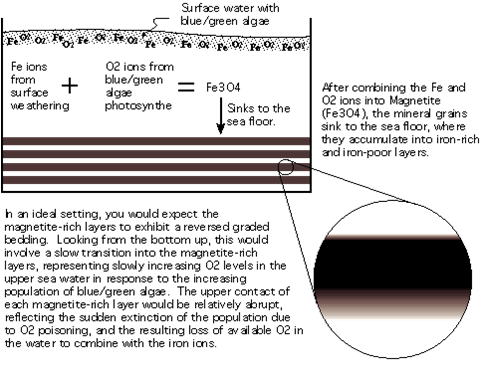
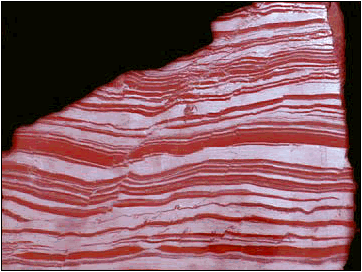
The absence of oxygen gas meant that the early atmosphere was a reducing chemical environment. Although there has been some debate over this claim (with some scientists suggesting that the atmosphere was, at best, only weakly reducing), more recent work supports the claim of a reducing atmosphere. This is important, chemically, because it means that complex biological molecules could accumulate - without being destroyed by oxidative processes.
B. The Formation of Biologically Important Molecules
Life is complex, and is composed of complex subunits. Reductionism and probability imply that complex cells probably did not form spontaneously with all of their structures and functions intact. Rather, naturalistic, reductionistic models hypothesize that subunits would have to form first and then come together. At the most fundamental level, we might expect monomers to form, and then polymers, and then cell-like structures.
1. The source of biologically important monomers
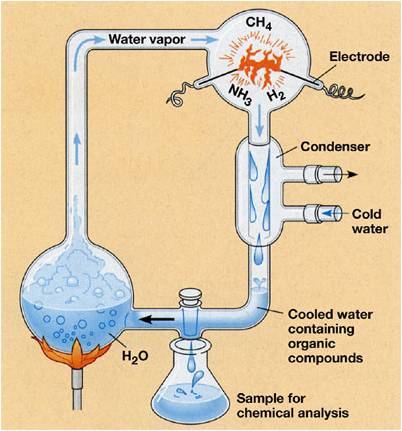 a.
Spontaneous generation on Earth
a.
Spontaneous generation on Earth
In the 1920's, Alexander Oparin and J. B. S. Haldane independently hypothesized that biologically important monomers like amino acids and sugars might form spontaneously if a mixture of volcanic gases were bombarded with energy in a reducing environment. Curiously, this hypothesis was not effectively tested until 1953, when Stanley Miller and Harold Urey sent electric charges through gaeous mixtures of H2O, CH4, NH3, CO, and H2. In their closed system, the gases were condensed and dissolved solutes accumulated in solution. After a week of running the experiment, they found several amino acids in solution; confirming the Oparin and Haldane hypothesis that biologically important monomers could form spontaneously. Although scientists challenged the appropriateness of their gas mixture (volcanic gases contain other gases, too) and the constantly high application of electric discharge, more recent experiments using a wide variety of volcanic gases and other sources of energy also produced a wide variety of amino acids and all other biologically important molecules including nitrogenous bases, ribose, deoxyribose, fatty acids, phospholipids, and a variety of other sugars and other organic molecules. Although Miller and Urey surmised that the initial source of energy might be lightening strikes at the surface of the earth, other scientists have considered other locations for the synthesis of biologically important molecules. Günter Wächtershäuser (1990) suggested that hydrothermal vents might be a likely spot, where rich mixtures of volcanic gases are released under high heat and pressure directly to the surrounding water. Critics suggested that temperatures may be too hot for molecules to persist, but it is possible that cooler hydrothermal vents called "white smokers" might have been involved.
b. Seeding from Space
In 1969, the Murchison Meteorite fell to earth in Australia. Examinations revealed the presence of amino acids and other organic molecules, leading some scientists to suggest that the period of heavy meteorite bombardment could have seeded the earth with biologically important molecules necessary for life to emerge.
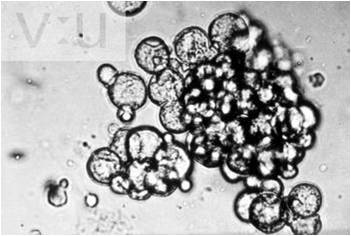 2.
Formation of Polymers
2.
Formation of Polymers
Polymerization of all biologically
important molecules works by the simple proces of dehydration synthesis, and
it didn't take long for scientists to polymerize amino acids spontaneously.
In the 1960's, shortly after the Miller-Urey experiments, Sidney W. Fox discovered
that amino acids would polymerize into small spheres composed of proteins -
'proteinoids microspheres' at fairly low temperatures (70oC) if phosphoric
acid was present as a catalyst. He found similar microspheres in volcanic lava
on Hawaii, and suggested that this might be a spontaneous process by which proteins
could have formed. These microspheres are differentially permeable, and they
also bud (split into two spheres) when they enlarge. Fox thought these could
have been the first 'membranes', creating a unique chemical environment in which
other reactions could occur. In the 1960's Cairns-Smith demonstrated that clay
particles could act as a polymerization template. The specific charge characteristics
on a clay surface would bind a non-random (but not explicitly sequence specific)
series of amino acids, and drying at warm temps would cause polymerization.
In 2004, Szostak showed that RNA nucleotides coul polymerize on clay surfaces,
as well. Again, proponents of a hydrothermal vent origin of life argue that
these types of polymerization reactions would be quite possible (and more stable)
under the conditions at these vents.
C. Acquiring the Characteristics of Life
A soup of biologically important molecules is not a living cell. Once again, we are confronted by a seemingly impossible process of creating complexity from simple parts. As daunting as this questions sounds, scientists have made considerable progress in shedding light on how this process might have happened. In short, there are three basic functions that a cell must perform: 1) it must be be a bounded system that, as a consequence of differential permeability, can become different from its environment; 2) it must acquire matter/energy and harvest energy through metabolic process; and 3) it must have a genetic system that can co-ordinate this metabolic activity and also replicate. Surprizingly, there are very good hypotheses about how each of these steps might have occurred. However, there is still little agreement on the order in which these steps would have occurred. So, we will present these steps separately, but no order is implied.
 1.
Evolution of a membrane
1.
Evolution of a membrane
When Hydrogen cyanide and formaldehyde are added to Miller Urey experiments, phospholipids form spontaneously. In a turbid environment, wave action will cause these films to ball-up as single-layer micelles and as phospholipid bilayers. As you know, these bilayers form the semi-permeable membrane found in all living cells. So, the formation of a membrane is the easiest and most well-understood piece of the puzzle.
2. Metabolic Pathways
Metabolic pathways are often complex; a useless substrate is modified and changed into something else by an enzyme (enzyme 1). This intermediate is modified by another enzyme (enzyme 2), and is converted into another intermediate. Finally, this intermediate is modified by a third enzyme (enzyme 3), and a useful functional product is made.
Substrate A ---> intermediate B ---> intermediate C ---> useful product D
|
|
|
enzyme 1 used enzyme 2 used
enzyme 3 used
- It seems like all three enzymes have to be present at once for the useful product to be made. It couldn't occur by a stepwise process, because a system with just the first step (substrate A to intermediate B) isn't functional - there is no useful product and it dies! So, it seems that all the steps have to be present at once. Again, this is the argument of intelligent design. Do you recognize it? A stepwise process is impossible; this is too complex; everything has to be present together for it to work - be it the eye, a new species, a new gene, or now, metabolic pathways. It is all Paley's old argument, wrapped in new clothes. Well, as with the evolution of the eye, there IS another possibility.
Suppose useful product D is present in the primordial environment. All the protocells are gobbling it up and using it. Well, we might expect the concentration of D to drop. If the useful product "D" is now in short supply, then selection will favor protocells that can make it out of something else - making it on their own and not relying on environmental supply. Maybe they can absorb something similar, like substance C, and "tweak" it chemically into D. So, selection will favor the evolution of the pathway: C--> D, even if C can't be used for anything else.
So, if this pathway is adaptive, then cells with this pathway increase in frequency. Generations later, only protocells with this pathway exist, and all the cells are competing for substrates D (which they can still use when they find it) AND substrate C, which all cells convert to useful product D.
Now, as substrate C decreases in supply (because cells are using it to make D), selection will favor protocells that can convert B into C, and thus into D: B--> C --> D.
Thus, useless intermediate substrates are added to the process in a sequence that is the "reverse" of the direction of the pathway, itself; and a complex pathway of A--> B --> C --> D evolves by a stepwise process.
- Many pathways are fundamentally quite similar - electron transport chains, etc. As is often the case in biological systems, once a functioning system evolves it is often "co-opted" for other functions - like electron transport systems are used in photosynthesis and respiration.
 3.
Genetic System:
3.
Genetic System:
a. Problem:
DNA requires protenaceous enzymes to be replicated and read, but proteins require a DNA recipe... neither can function without the other in living cells. Again, we have an apparently "irreducibly complex system" - it all must be there at once to work. You need an information storage molecule (DNA), and a catalyst to access the information (proteins). Both of these functions must be present at the same time for the system to work.b. Possible Solution:
But there is another component of our genetic system....RNA. And we are finding that RNA does lots of wild stuff....
a.Even in current systems, RNA is message (m-RNA), decoder (r-RNA), and transporter (t-RNA).
b. RNA's have been discovered that have catalytic ability (ribozymes), so they can act as an information storage molecule (like DNA) and as a catalyst (like proteins).
c. some RNA molecules can self-replicate.
d. some RNA molecules (mi-RNA, si-RNA) regulate the production of proteins.
So, the possibility exists that genetic systems evolved from self-replicating RNA molecules. Coding for proteins that assist the replication process would be adaptive. And incorporating DNA, which is more stable than RNA, would also be adaptive, producing the system seen today. This idea has been developed into a more formal hypothesis of the evolution of genetic systems, which we will describe next.
c. Hypothesis for the Evolution of a Genetic System:
 - GENETIC SYSTEM #1: Self-Replicating RNA Arises Spontaneously:
- GENETIC SYSTEM #1: Self-Replicating RNA Arises Spontaneously:
- Self-replicating RNA forms by polymerization of spontaneously produced nucleotides.
- It replicates. That's all it has to do to be a successful genetic system...replicate. Consider this: 90% of your DNA does not code for proteins - in some cases it may be regulatory, but there is ALOT of DNA that seems to have no function at all. However, when the DNA is replicated, this non-coding DNA is passed along to the next generation, too. In that sense, it is just as successful as the genes that do code for a protein. So, replication is REALLY all that a genetic system has to do to perpetuate itself through time.
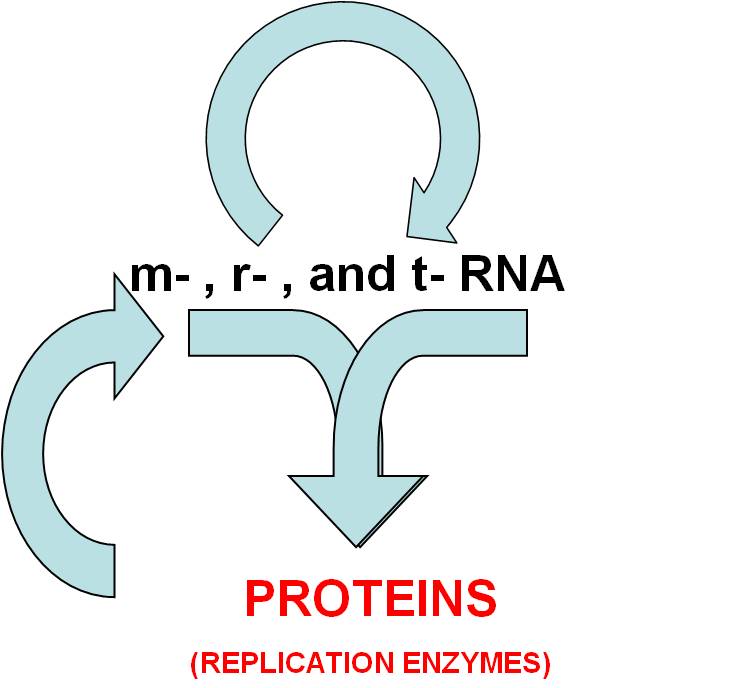 - But, it could replicate more effectively if it coded for replicating proteins.
So, m-RNA and r-RNA and t-RNA interact today to make proteins. If this
step happened next, then the replicating RNA might code for a protein
(an RNA polymerase) that increased the efficiency of its replication.
- But, it could replicate more effectively if it coded for replicating proteins.
So, m-RNA and r-RNA and t-RNA interact today to make proteins. If this
step happened next, then the replicating RNA might code for a protein
(an RNA polymerase) that increased the efficiency of its replication.
- GENETIC SYSTEM #2: RNA systems produces useful replication enzymes.
- So, now there is VARIATION IN GENETIC SYSTEMS... the old, slow, self-replicating RNA, and the new, more rapidly replicating RNA that codes for replication enzymes. So, we have variation and DIFFERENTIAL REPRODUCTIVE SUCCESS... different RNA's that replicate (reproduce) at different rates. What will happen????? Well, the more rapidly replicating molecules will be accumulate over time. They will increase in frequency in the "population" of chemicals...this is selection at a chemical level.
- GENETIC SYSTEM #3: Incorporating DNA
- Now, how and why does DNA get involved? Well, first the how. If the RNA has a small mutation, it may make a slightly different protein... the protein might now link DNA nucleotides together, rather than RNA nucleotides (like the existing RNA replication enzymes). This new enzyme is a 'reverse transcriptase' - it reads RNA and makes DNA. So now, the RNA is read and a DNA molecule is made. (Does this ever really happen today? Are there enzymes that do this? Yes, in retroviruses there are genes that code for reverse transcriptases that copy the viral RNA, make DNA, and then the DNA is inserted into the host's genome. When this viral DNA is transcribed, the new viral genome of RNA is made.)
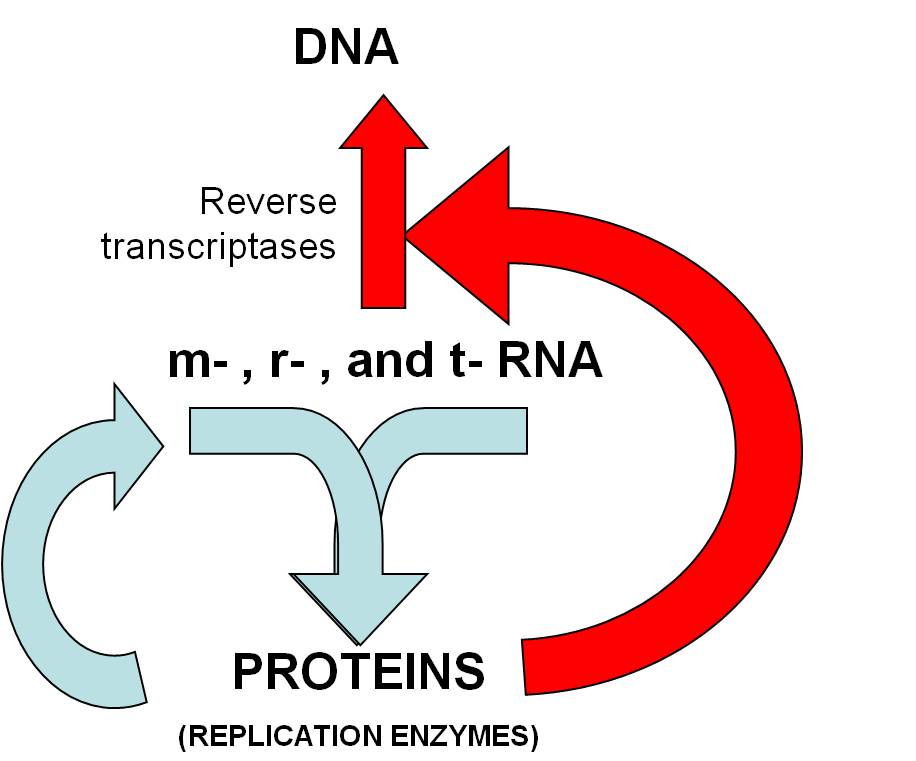 - So, there is now a DNA molecule, and a DNA polymerase that can make a copy
and make it double-stranded. There are also RNA polymerases (present already)
which read a nulcei acid and make RNA. So, here we have evolved a system
where DNA codes for RNA that codes for protein, and proteins are used for DNA
replication, transcription, and translation, JUST LIKE THE GENETIC SYSTEM WE
HAVE TODAY.
- So, there is now a DNA molecule, and a DNA polymerase that can make a copy
and make it double-stranded. There are also RNA polymerases (present already)
which read a nulcei acid and make RNA. So, here we have evolved a system
where DNA codes for RNA that codes for protein, and proteins are used for DNA
replication, transcription, and translation, JUST LIKE THE GENETIC SYSTEM WE
HAVE TODAY.
- Why? Why would DNA be advantageous? Because its' double helix is more stable than the single helices of RNA. Greater stability means fewer mutations, which is a good thing (adaptive). In addition, a two-step process of protein synthesis produces more proteins than a one-step process. Here's the idea in a nutshell. Suppose nucleic acids can be read at a given rate - say, 5 products per second. In a one-step process (RNA coding for proteins), 5 proteins can be made by reading the RNA template each second. So in two seconds, 10 proteins can be made. However, suppose that the first second was used to make copies of the RNA template? In a two-step process of DNA--> RNA--> protein, the first second is used to read the DNA and make 5 products... but these products are 5 RNA molecules. In the next second, each of these 5 RNA's can be used as a template for protein construction, with 5 proteins made off each of them...for a total of 25 proteins after 2 seconds. More productive.
d. How has science tested this hypothesis?
Well, the history goes like this. After the discovery of ribozymes, some scientists saw that RNA could act as both information storage (recipe) AND catalyst (like enzymes). And, since RNA does everything in today's genetic system anyway, the "RNA-first" hypothesis was raised.
So, scientists tested the premise that RNA could self-replicate. They
tested and confirmed this hypothesis - they synthesized molecules that, under
particular 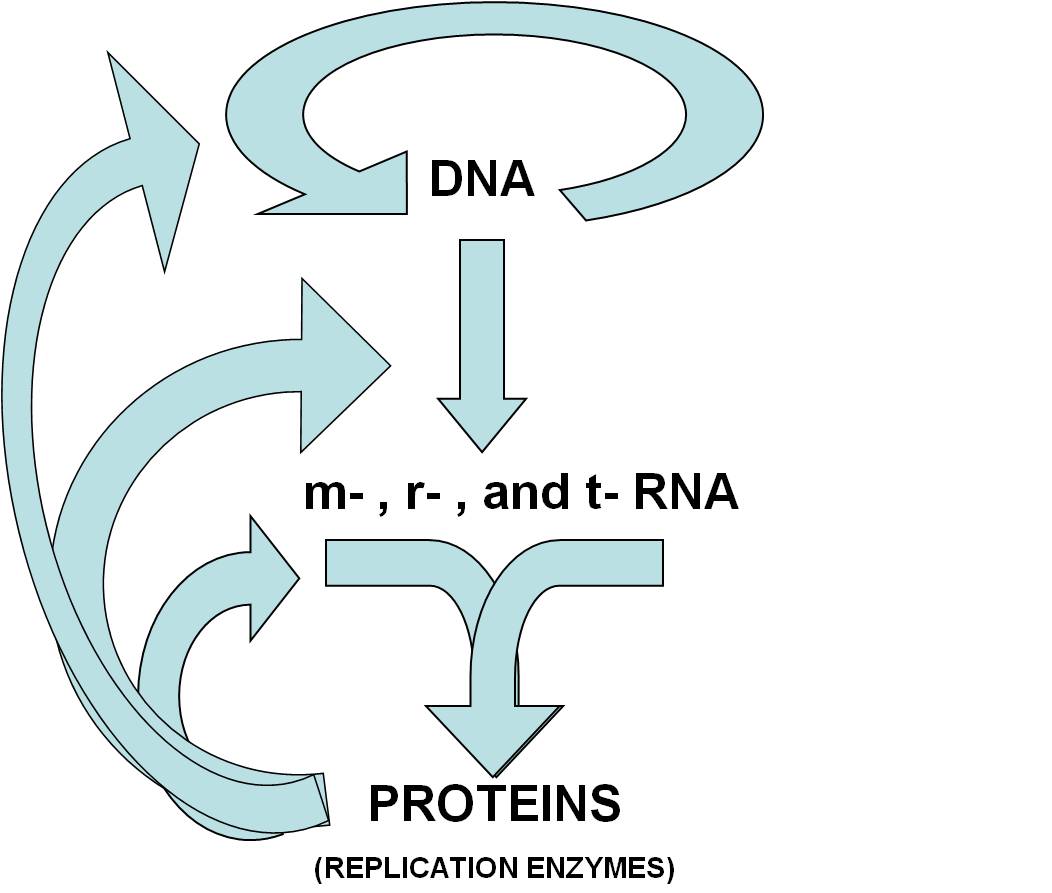 conditions, did self-replicate
(Hypothesis tested and confirmed, in part).
conditions, did self-replicate
(Hypothesis tested and confirmed, in part).
Second, scientists realized that RNA would have to code for DNA to get from SYSTEM #2 to SYSTEM #3. They saw that the existence of retroviruses that confirm this requirement. Retroviruses, like HIV, have an RNA genetic system. They insert this in their host's cell, and this RNA is read like any other m-RNA molecule. One of the genes on the RNA codes for a protein called "reverse transcriptase". This enzyme reads the viral RNA and links together complementary DNA bases - it reads RNA and makes DNA (the reverse of transcription, thus 'reverse transcriptase'). The DNA is then incorporated in the host's genome - it is spliced right into a chromosome. And now, anytime the cell replicates its OWN DNA and divides, the viral gene gets copied and gets passed to the daughter cells. Eventually, some environmental cue stimulates the viral DNA to be read, and its expression (coding for copies and viral replication) kills all the host cells that have descended from this original infected ancestor.
So, parts of this hypothesis have been tested. However, the entire process of evolving a DNA-based genetic system from an RNA-based genetic system has not been done yet. It is certainly intriguing stuff. There is certainly enough evidence, it would seem, to suggest that the hypothesis "IT CAN'T HAPPEN" (such as intelligent designer's claim) needs to be put on hold for a while. Thankfully there are curious people who continue to ask questions.
Scientists continue to find new properties to RNA. Lately (since 2002), a new class of regulatory molecules have been found that can turn genes off. They are short strands of RNA, called "interference-RNA" (mi-RNA and si-RNA). They bind to either DNA or to the m-RNA transcript - they block protein synthesis and effectively turn a gene off. So, RNA not only is a message, a decoder, and a transporter, it is also a genetic regulator. Many medical researchers are trying to use these short pieces of RNA as a blocking agents to stop the progression of genetic diseases.
This pathway is now accepted in the scientific community as a "plausible hypothesis" for the evolution of a genetic system. There is impressive support thus far, but all elements of the hypothesis have not been confirmed. THE SEARCH FOR KNOWLEDGE CONTINUES....!!
D. Summary:
STEPS REQUIRED FOR THE SPONTANEOUS, NATURAL FORMATION OF LIFE, and the evidence to date:
1. Spontaneous synthesis of biomolecules - strong evidence; Miller-Urey experiments.
2. Polymerization of monomers into polymers (proteins, RNA, sugars, fats, etc.) - strong evidence; Fox and Cairns-Smith experiments.
3. Formation of membranes - strong evidence; behavior of phospholipids in solution.
4. Evolution of metabolic systems - reasonable hypotheses, and genetic similarity in genes involved in particular pathways (suggesting gene duplication and susequent evolution of new genes and elaboration of existing pathways)
5. Evolution of a genetic system - a reasonable hypothesis and significant corroborating evidence that it could happen. But no experimental evidence of the process evolving through all three steps.
6. How did these three elements (membrane, metabolism, genetic system come together?) a few untested hypotheses.
So, as you can see, there are several elements of this hypothesis that have various levels of support.
Study Questions:
1. How old is the Earth, how old are the oldest rocks on the Earth, and how
old are the oldest fossils on Earth?
2. What were the major gases in the Earth’s early atmosphere? Where did
it come from?
3. When did oxygen begin to accumulate in the Earth’s oceans? Where did
it come from? What geological evidence do we have of this change in ocean chemistry?
4. What are the three minimal requirements of a living system?
5. How could a membrane evolve?
6. How might a complex metabolic pathway, consisting of a process whereby a
substrate is converted into useless intermediates on the way to the formation
of a useful product, evolve by a stepwise process in which each step is favored
by selection?
7. What two attributes of RNA lead biochemists to hypothesize that RNA may have
been the first genetic system?
8. How and why might the synthesis of proteins by RNA have evolved?
9. How and why might have DNA been incorporated into this process?
10. How do retroviruses replicate?
11. How do ‘origin of life’ questions and evolution differ?